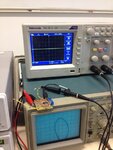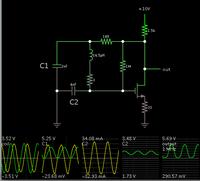Woody2
Newbie level 6
Hi,
I'm working on a project for school that includes this colpitts circuit from ALD.
https://www.aldinc.com/pdf/fet_11122.0.pdf

The main component being the zero-treshold mosfets (ALD110800).
Now, the problem is that I can only use an inductor of 16.5µH, so according to the formula F=1/(2πvLC) I can lower the inductance if I raise the capacitance. So this is what I came up with for a colpitts running at 1MHz.

However, I built this circuit but it seem to oscillate. So I ran some Pspice simulations. Things seem to be working fine here.

(Red being the drain of M1 and green being Vout.)
So I checked the phase shift to make sure I had a total of 360°.
Here is the inverter

Shifting 171°, so the filter should be able to shift 189°
Here's the filter

Not a problem.
Yet nothing happens in reality, what am I overlooking? :-?
Any advice is greatly appreciated.
ps:
In their schematic, ALD provides a capacitor in series with the inductor, yet information about this is nowhere to be found. In their simulations they didn't use it at all. We e-mailed them about this but never got a reply. Does anyone know the purpose is of this capacitor? Or what its value should be if used?
Thanks
I'm working on a project for school that includes this colpitts circuit from ALD.
https://www.aldinc.com/pdf/fet_11122.0.pdf

The main component being the zero-treshold mosfets (ALD110800).
Now, the problem is that I can only use an inductor of 16.5µH, so according to the formula F=1/(2πvLC) I can lower the inductance if I raise the capacitance. So this is what I came up with for a colpitts running at 1MHz.

However, I built this circuit but it seem to oscillate. So I ran some Pspice simulations. Things seem to be working fine here.

(Red being the drain of M1 and green being Vout.)
So I checked the phase shift to make sure I had a total of 360°.
Here is the inverter

Shifting 171°, so the filter should be able to shift 189°
Here's the filter

Not a problem.
Yet nothing happens in reality, what am I overlooking? :-?
Any advice is greatly appreciated.
ps:
In their schematic, ALD provides a capacitor in series with the inductor, yet information about this is nowhere to be found. In their simulations they didn't use it at all. We e-mailed them about this but never got a reply. Does anyone know the purpose is of this capacitor? Or what its value should be if used?
Thanks






